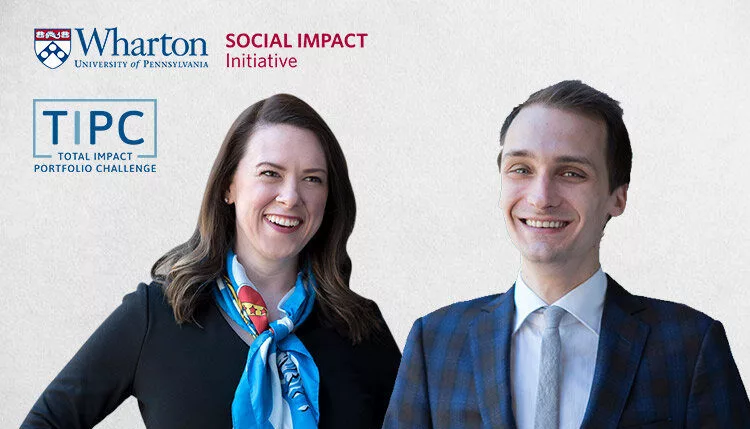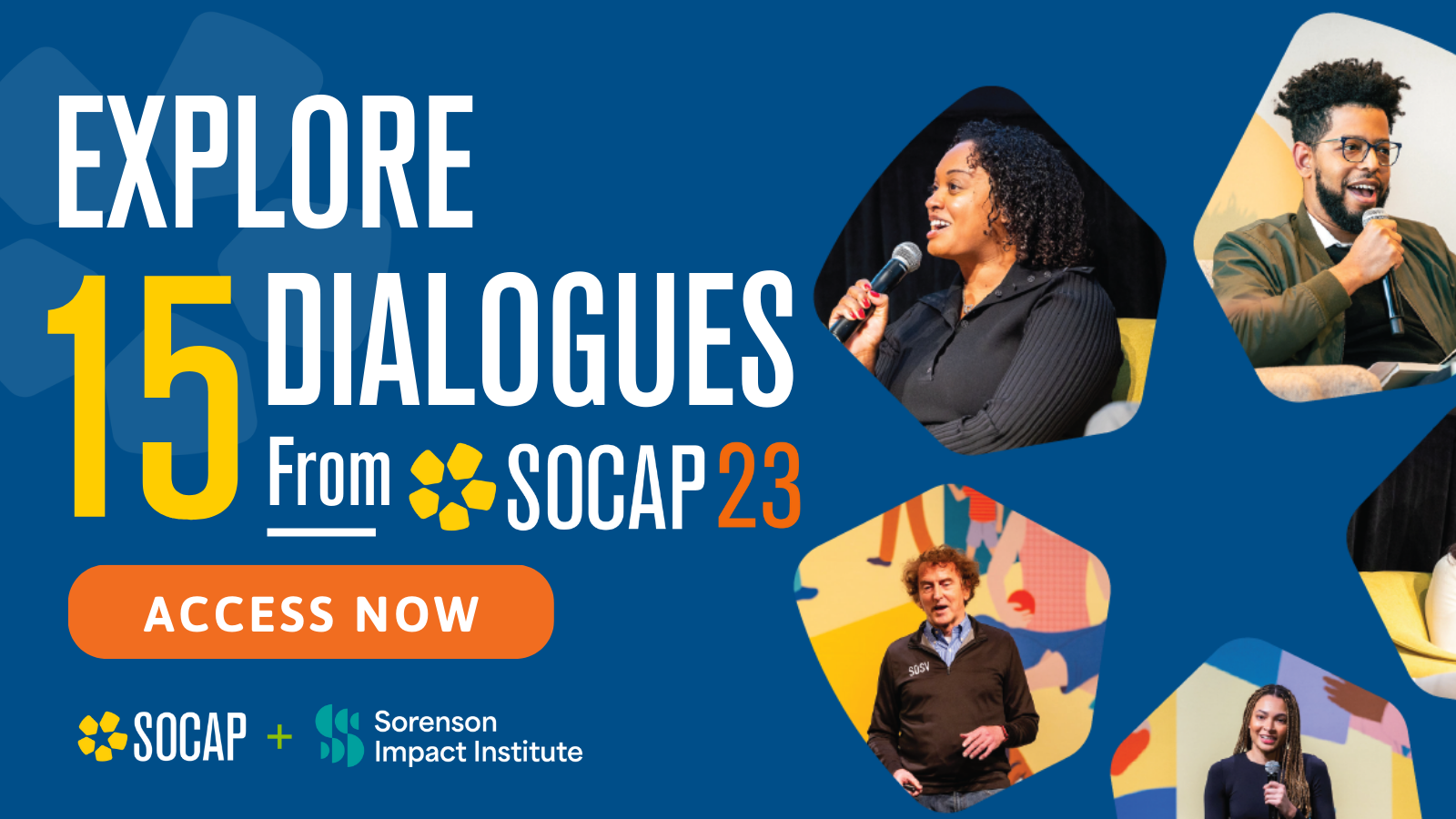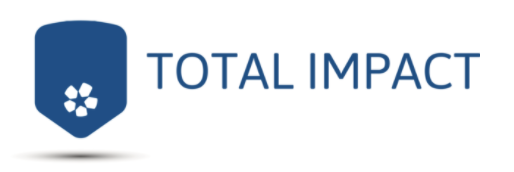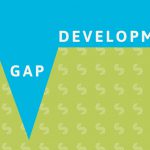For the second year in a row, Total Impact and Wharton Social Impact Initiative have collaborated to produce the Total Impact Portfolio Challenge. To win the Challenge, teams of graduate students from all over the United States are competing to build the strongest “Total Impact” portfolio – based on a mock portfolio profile – that integrates impact across asset classes.
Part of the world’s leading research-led business school, Wharton Social Impact Initiative has a mission to build the social impact evidence base, talent pipeline, and community to advance business solutions for a better world. They produce leading-edge academic research and experiential training opportunities focused on impact investing that benefits students and industry professionals alike. As a partner in the Total Impact Portfolio Challenge, Wharton Social Impact Initiative is providing training and educational support to participating students throughout the competition.
We recently sat down with Sandi Hunt, Wharton Social Impact Initiative’s Managing Director, and Tyler Hoffman, WSII’s Associate Program Manager to discuss the Total Impact Portfolio Challenge and how programs like this one are helping to build the impact investing leaders and ecosystem of tomorrow. The following is a transcript of our conversation.
On May 13th, 2020 from 3-5 pm EST, the four finalist teams (University of Vermont, Fordham, UC Boulder, and USC) will present their portfolios and investment rationale virtually to an expert panel of judges. Register for free to see how some of the top graduate students in the country would use the power of capital markets to deliver both financial and social returns: Register here
TOTAL IMPACT: CAN YOU TELL US ABOUT THE WHARTON SOCIAL IMPACT INITIATIVE AND YOUR GUIDING MISSION?
Sandi Hunt: Wharton Social Impact is the hub for all things at the intersection of business and impact here at Penn and Wharton. To summarize our work, we do the two things that this institution does best to advance this work: one, we conduct rigorous, relevant research at the intersection of business and impact, and two, we deliver high-quality experiential learning opportunities for students on this campus and around the world.
TOTAL IMPACT: HOW DO YOU SEE EXPERIENTIAL STUDENT COMPETITIONS LIKE TOTAL IMPACT PORTFOLIO CHALLENGE TYING INTO YOUR VISION FOR THE INITIATIVE OR ITS LARGER STRATEGY?
Sandi Hunt: Delivering high-quality experiential learning programs helps us fulfill our role helping to train future leaders in this space–we call it our talent pipeline effort. For us, this means responding to the market and providing what today’s students want. We are seeing two major trends.
The first is a priority for impact. We see students prioritizing impact in their course selection, in their extracurricular work, in their careers, in their own personal values, and how those are reflected in their behaviors.
The second is that today’s students are expressing a very significant desire for experiential learning opportunities while they’re at school to supplement their classroom hard skills. That’s really what we see students wanting these days– an experience where they’re coming to school and learning through their curricular efforts in the classroom, and then participating in labs, programs, and opportunities where they can take those skills, put them to work, and see them in action. And that is something that we’re seeing not only increased student demand for, but also from industry. More and more, firms are selecting candidates that have, not only an interest in impact investing and classroom experience in impact investing but who have actually done deals and portfolio challenges. The Total Impact Portfolio Challenge was a way for us to reflect that.
A lot of students who study business are going to go on and work in portfolio construction and, when it came to impact programs and competitions those students could access during their education, we saw that there was not a lot happening that looks across asset classes for portfolio construction. That need wasn’t really being addressed by any experiential learning program. We’re happy to collaborate with our friends at Total Impact on putting this together to meet that market demand.
TOTAL IMPACT: YOU’VE ALREADY MENTIONED A FEW EXAMPLES, BUT WHAT ARE SOME OF THE OTHER REASONS WHY STUDENTS PARTICIPATE IN A PROGRAM LIKE THE TOTAL IMPACT PORTFOLIO CHALLENGE? WHAT ARE SOME OF THE LIKELY BENEFITS OF PARTICIPATION?
Tyler Hoffman: We want to inspire the next generation to address the world’s most critical challenges, with inspiration as only the first step. The Total Impact Portfolio Challenge is aiming to bring together students who are looking to make a difference through the application of the hard skills that they’re building through their education.
Practically speaking, we want students who are aspiring portfolio managers and investment advisors to gain real experience constructing an investment portfolio with an impact focus across all asset classes. And we’re seeing that experiential learning that supplements the student’s own degree programs are very popular. And so the Total Impact Portfolio Challenge is looking to address this demand. Our hope is that students will bring their inspiration and practical experiences to their professional work after they’ve graduated after they’ve participated in the TIPC program and they’ve become the world’s next business leaders.
TOTAL IMPACT: COMPETING TEAMS RECEIVE EDUCATIONAL SUPPORT THROUGHOUT THE COMPETITION. CAN YOU HIGHLIGHT A FEW EXAMPLES OF THE KINDS OF RESOURCES STUDENTS RECEIVE AND HOW THEY BENEFIT FROM THEM?
Tyler Hoffman: We have an online TIPC platform called Canvas. Canvas offers the students various resources and tools to help them along the process of building out an investment portfolio for the program. We offer CFA Institute curriculum materials which are really to help ensure that the essential basics and subjects like finance and ethics are covered and are provided to all of the participating students. And then we also have various webinars and reports from institutions like the Commonfund Institute and our own Wharton Social Impact Initiative so that students have the opportunity to dig in and learn more about how social impact can fit into the investment process.
And then we have various tools available to the students in Canvas that might not already be available through their own networks. For example, they all get a subscription to a Wharton Research Data Services account, which is a paid service, but it’s free through the TIPC program. Wharton Research Data Services is a robust data platform that students can use to not only access all the relevant data that they would need in order to work on their TIPC portfolios, but it’s also a cutting edge research space, and analytical tool as well. So they can dig in and take what they need but they can also go even deeper to learn more if they so choose. Another example is the school resource guide offered in Canvas. This guide indicates all the individual resources that participating schools have to offer to their students. So, not only are the students learning from the TIPC platform on Canvas, but they also have the ability to learn how to best make use of their own university’s resources, which can be used for TIPC and everything else they might be working on.
TOTAL IMPACT: ARE THERE ANY EDUCATIONAL RESOURCES THAT ARE NOT IN EXISTENCE YET THAT WOULD BE BENEFICIAL TO THE GROWTH OF THE IMPACT FIELD?
Tyler Hoffman: There are ample opportunities for students to engage with the impact venture space, but we have seen a very clear gap in terms of social impact minded portfolio management–which is where a lot of the jobs are. The TIPC program was created to help fill that educational gap.
We’re in the second year of the TIPC program and we’re continuously exploring for new and additional resources that might benefit participating students. Following the program, we will ask participants what they think would have been helpful as they were going through the process and what materials they wish they had access to. Their answers will help us continue to develop and improve the program upon each iteration.
Ultimately, our goal is to provide a more structured curriculum. We have resources and tools, but a specific curriculum that leads students along a clear pathway does not yet exist. I think what’s exciting right now is that the students have a lot of ability to experiment and be creative, and dig in where they think they need to dig in. In the future, I would like to see a clearly defined curriculum that’s really going to give them a strong starting place. We’ve got some of that now and we only hope to grow that in the future.
Sandi Hunt: TIPC is one of two programs Tyler leads. The other is our MIINT program, the MBA Impact Investing Network and Training program on which we collaborate with the Bridges Impact Foundation, which has been around now for a decade. What we’ve been able to see from the growth of that program really speaks to Tyler’s point about the development of a curriculum. What began with a collection of resources grew into the full MIINT program with deliverables, quizzes, formal assignments, and formal training modules. The program is an education in and of itself. We have a roadmap for how these programs can evolve in their sophistication and content.
TOTAL IMPACT: SANDI, YOU’VE JUDGED MANY IMPACT COMPETITIONS OVER THE YEARS. WHAT INSIGHTS CAN YOU GIVE INTO WHAT THE JUDGES ARE LOOKING FOR WHEN ADJUDICATING THE PORTFOLIOS THE STUDENT TEAMS SUBMIT?
Sandi Hunt: The first word that comes to mind is creativity. This may not be the first thing that comes to everyone’s mind when it comes to finance. One thing we were intentional about is not making the mock profile for the Challenge too specific; we left some room for creativity. We will offer preferred impact themes, but we are always very fascinated to see what students teams come back with within and beyond those. They might say, the prompt included themes A and B, but we think, given that this particular prompt has to do with this geographic area, it would be foolish to not include C and D environmental factors in the analysis of the portfolio. There’s a lot of room to be creative and I think that that’s actually very reflective of the field right now.
We’re seeing new products come onto the market all the time. We’re seeing a good amount of variability in the product that exists within these umbrellas of ESG or impact. And so it leaves a very healthy amount of creative flexibility for the students to say, here’s what this meant to us. Here’s what we think this should mean within the world of this particular impact charge. We weren’t just looking at the funds that said they cared about this. We were looking for funds that screened on these particular dimensions. And so it was very fascinating to see how, even within the same parameters, we see a healthy diversity of ways that the teams are putting together their final deliverables and their portfolios. And I think that is probably the most important and maybe the most unexpected thing you hear about a portfolio competition: just how much room there is for innovation right now.
TOTAL IMPACT: WHERE DO YOU SEE THE PORTFOLIO CHALLENGE GOING IN THE FUTURE, AND WHAT IMPACT DO YOU HOPE THAT IT WILL HAVE?
Tyler Hoffman: As the TIPC program moves towards the conclusion of its second year, we’re going to be taking all the lessons learned, by both the students and the TIPC teams, so that we can further develop the curriculum and the resource materials that we’re offering through the program. The hope is, as the program materials expand, we’re going to be engaging with an even broader representational pool.
We want the program to continue to grow and provide students with practical experience in portfolio management and impact. The hope is that experience with the TIPC program is going to make students more marketable as workers when they hit the job market.
Another thing that we really love about TIPC right now is that it is free and we like how it’s democratizing the impact investing learning experience for all the schools. We want more schools and students to participate so that we’re reaching a broader, more diverse audience. We want programs like TIPC to be accessible to anyone that would be interested in learning more and participating.
Sandi Hunt: It makes us optimistic about this next generation to see so many students prioritizing impact. It is so heartening. It’s a breath of fresh air every year, meeting these students, and seeing their commitment. It’s so powerful to see the role that business and the market can play in driving impact. And it’s great to see these students — these incredibly passionate, ambitious young minds — choosing this as somewhere they want to spend their time, choosing this as something they want to prioritize in their career. That is a real bright spot in our lives and our careers. We thank them.
The fabulous founding managing director of Wharton Social Impact, Sherryl Kuhlman, who I worked for for many years until I stepped into her very big shoes in 2020, said something I won’t forget. I wrote it on what is now a very well-worn Post-it note:
Wharton Social Impact is here because students demanded it.
And that’s the truth. We are here because, overwhelmingly, students are saying this is necessary: this is part of my education that I expect, I want, and I prioritize. It’s such an honor to serve them.






